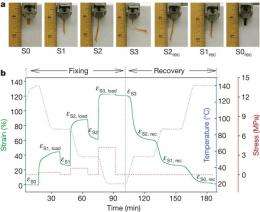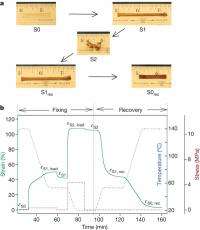March 15, 2010 report
Polymer remembers four shapes

(PhysOrg.com) -- A new study by General Motors has found that a polymer used commercially in fuel cell membranes can "memorize" four shapes, each assigned to a different temperature. The material could find applications in fields such as space exploration and biomedical engineering.
The material, a perfluorosulphonic acid ionomer (PFSA) called Nafion, is a shape memory polymer. These materials can remember shapes set under specific conditions of moisture content, temperature, light, or exposure to a magnetic field. When they are next exposed to the same conditions, they revert to the remembered shape.
Shape memory polymers have been known for decades, and have been used in wiring insulation and other industrial applications. Tests have been carried out for medical purposes such as stents for clearing blood vessels of clots, and the US space agency NASA has also considered using shape memory polymers for applications such as unfolding antennas in space. Previous polymers have only been able to remember two or three shapes including the original shape, and Nafion is the first known material that can memorize four.
The research team, led by Tao Xie, heated thin films of Nafion, shaped it at a fixed temperature, and then cooled the material. They then repeated the process for other temperatures and shapes. When reheated the polymer reverted to the shape formed previously at that temperature. The shapes are locked in when the material is at its transition temperature, at which its structure changes from a frozen “glass” to a mobile “rubbery” phase. Nafion is able to hold more shapes than other polymers because it has a wide transition temperature range from about 55 to 130°C, leaving more temperature options available.

Xie said that each shape would be assigned to a specific temperature chosen by the manufacturer. As long as there is sufficient difference between the temperatures, the material has been demonstrated to be able to hold four shapes, but Xie said it may be able to hold more. The next step in the research is to investigate shape memory polymers that are more appropriate for bulk processing, and those with UV radiation resistance for use in space, or biocompatibility for use in medical applications such as self-tying sutures, bone implants and blood vessel stents.
The paper, by Tao Xie of the General Motors Research and Development Center in Warren, Michigan, is published in the journal Nature.
More information: Tunable polymer multi-shape memory effect, Tao Xie, Nature, 464, 267-270 (11 March 2010), DOI:10.1038/nature08863
© 2010 PhysOrg.com



















